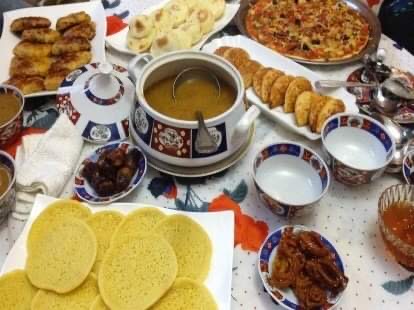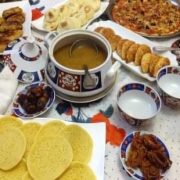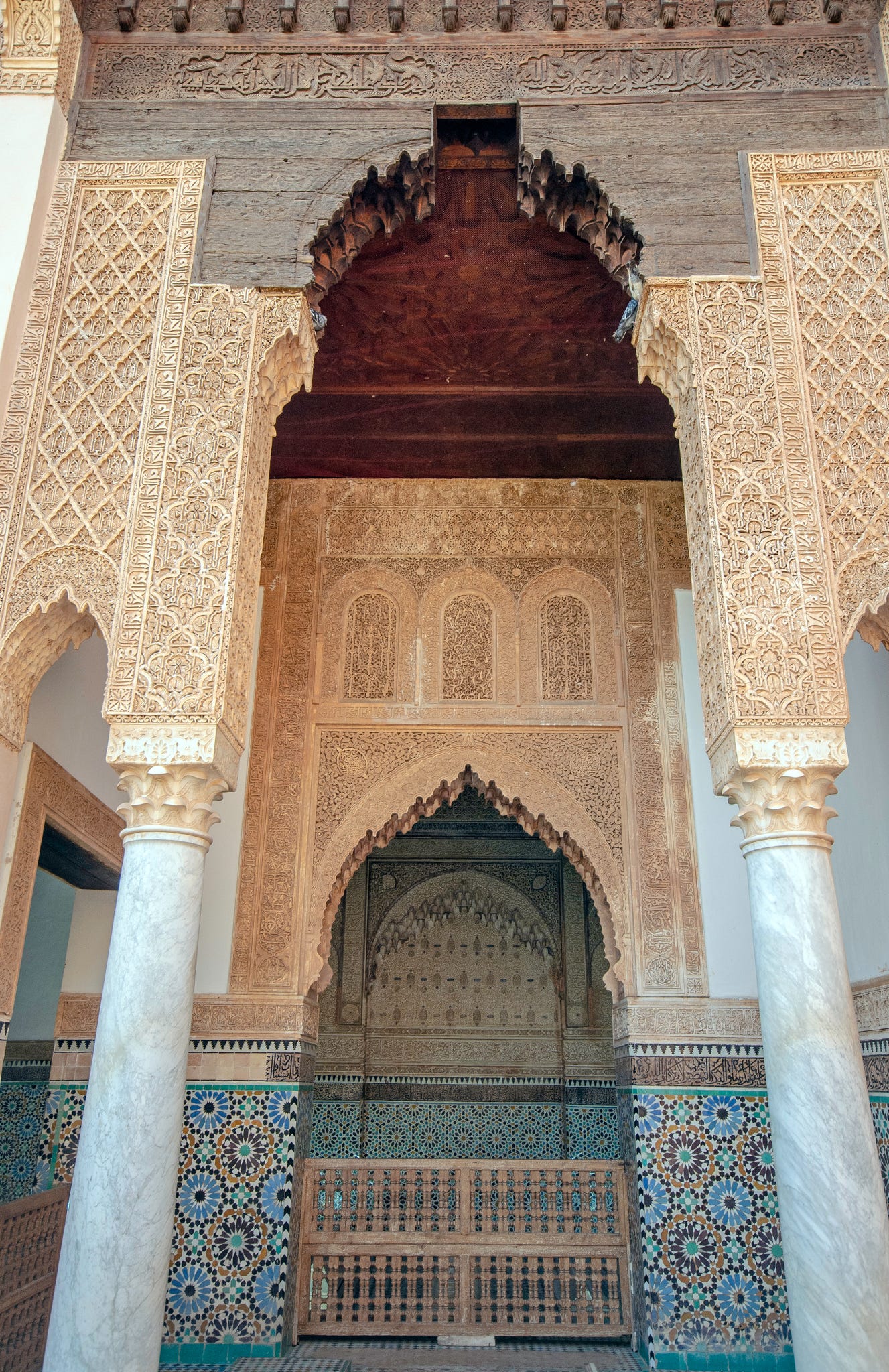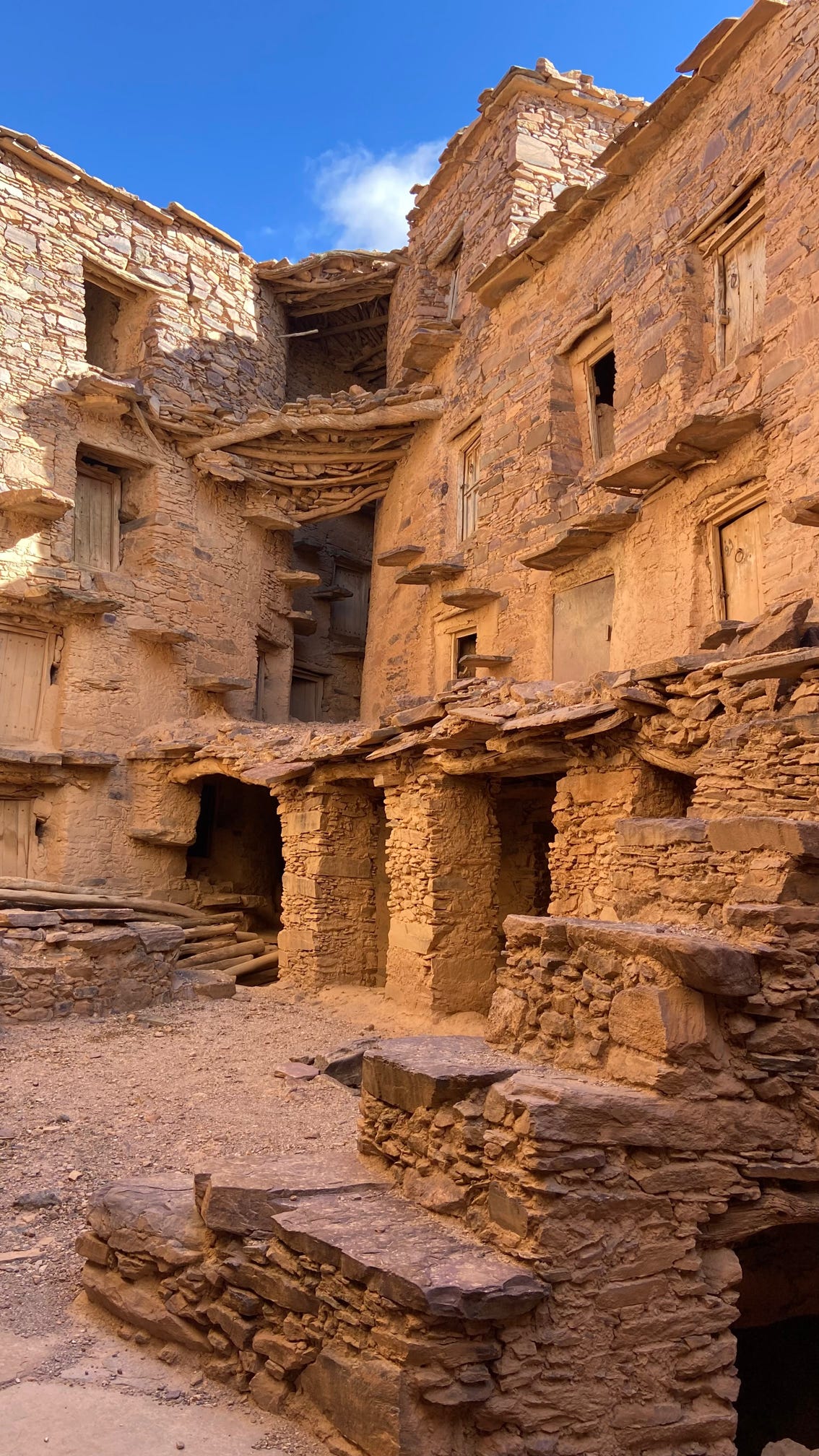
5 Amazing Moroccan Recipes – Exquisite Flavours of Tradition and Culture
Moroccan recipes are a flavourful and diverse representation of the country’s rich culinary heritage. The food in Morocco blends spices, fresh ingredients, and various cooking techniques to create dishes that are not only delicious but also steeped in history and tradition.
Flavourful and Spiced Dishes
Moroccan recipes are known for their bold flavors and aromatic spices. Commonly used spices include cumin, coriander, saffron, cinnamon, turmeric, paprika, and ginger, creating a distinct and complex flavor profile. Spices are often used in combination to create layered tastes in dishes, from savory to slightly sweet.
Tagine
Perhaps one of the most famous Moroccan recipes, tagine is a slow-cooked stew made with meats (such as lamb, chicken, or beef), vegetables, dried fruits (like apricots or prunes), and a variety of spices. The dish is named after the clay pot in which it’s cooked, allowing the ingredients to simmer together and develop rich, deep flavors. Chicken tagine with preserved lemons and olives is a popular variant.
Couscous
Another of our popular Moroccan recipes, couscous is made from steamed semolina wheat granules and is typically served with stews or vegetables. It’s often prepared for special occasions like Fridays or festive events. Couscous with lamb and vegetables is a common dish that highlights the comforting, hearty qualities of this food.
Pastilla
Pastilla (also called bastilla) is a savory-sweet pastry that combines delicate layers of thin dough (similar to filo pastry), stuffed with pigeon or chicken, almonds, cinnamon, and sugar. It’s a special dish often served at weddings or festive occasions, with its unique blend of sweet and savory flavors representing the complexity of Moroccan cooking.
Harira Soup
A rich and hearty popular Moroccan soup, there are many Moroccan recipes for harira! It is typically made with tomatoes, lentils, chickpeas, lamb, and a variety of spices. It’s often eaten during Ramadan to break the fast, but it’s enjoyed year-round as well. The thick, flavorful broth is often paired with dates and a fresh bread like khobz.
Moroccan Mint Tea
Moroccan mint tea, or atay, is an essential part of Moroccan hospitality. The tea is made with green tea, fresh mint leaves, and a generous amount of sugar. It’s served in small glasses and enjoyed throughout the day, symbolizing warmth, hospitality, and relaxation.
Mechoui
Mechoui is a traditional dish of roasted lamb, often prepared during large gatherings or celebrations. The lamb is slow-roasted on a spit, seasoned with spices like cumin and garlic, and then served with flatbread. It’s a dish that celebrates the communal and festive aspects of Moroccan dining.
Bissara
Bissara is a comforting fava bean soup often eaten in Morocco during cooler months. The beans are cooked with garlic, olive oil, cumin, and paprika, creating a flavorful and nutritious meal. It’s typically served with crusty bread.
Zaalouk
Zaalouk is a Moroccan eggplant salad that’s made by cooking eggplants with tomatoes, garlic, olive oil, cumin, and paprika. It’s served as a side dish or appetizer and has a smoky, tangy flavor that pairs well with bread.
Sellou (Sfenj)
Sellou is a sweet treat traditionally prepared for religious holidays, such as Eid al-Fitr. It’s a mixture of roasted flour, almonds, sesame seeds, and spices, often shaped into small balls or served in a powdered form. Sfenj, Moroccan doughnuts, are also a popular street food, deep-fried and dusted with powdered sugar.
Moroccan Flatbread (Khobz)
Khobz is a traditional round bread that accompanies almost every meal. It’s often served alongside tagines, stews, and soups. The bread is simple yet crucial to Moroccan dining, used to scoop up stews or dipped in olive oil.
Mechoui Lamb Sandwich
A delicious variation of mechoui, this dish features the roasted lamb stuffed into fresh bread with pickled vegetables, creating a satisfying and flavorful sandwich.
Orange and Cinnamon Salad
A refreshing yet simple Moroccan salad made from fresh oranges, cinnamon, and a sprinkling of sugar, often enjoyed as a light dessert or appetizer, especially during warmer months.
Moroccan Sweets
Moroccan desserts are often based on nuts, honey, and dried fruits. Popular sweets include chebakia (fried sesame pastries dipped in honey) and kaab el ghazal (almond-filled pastries). These treats are often served with mint tea.
Vegetarian Dishes
While Moroccan cuisine is known for its meat dishes, it also has a rich variety of vegetarian options. Dishes like couscous with vegetables, vegetable tagine, and salads made with tomatoes, cucumbers, and olives are commonly enjoyed in Moroccan homes.
Moroccan recipes reflect the vibrant and diverse culture of the country, combining ingredients and techniques that have been passed down through generations. Whether savory or sweet, the dishes are an essential part of the Moroccan way of life, and each meal is a celebration of tradition, flavor, and hospitality.
Moroccan recipes are known to be some of the best in the world, creating delicious food. The kingdom offers to its visitors an exceptional culinary experience. Marrakech, Fez, Agadir and Rabat are among tempting culinary destinations however all over Morocco you have the chance to try tasty freshly prepared food.
More than 15 Moroccan restaurants are amongst the 1000 best restaurants worldwide, according to La Liste. Enjoy the best Moroccan culinary delights has to offer to you. Mint tea, Tajine, Couscous, or Pastilla, are all waiting for you!
Until you visit here are a few more Moroccan recipes that you can try at home……
Moroccan Recipes – Batbout
Also known as mkhamer or toghrift or matlou’, it features a soft and chewy texture and, if
cooked properly, a pita-like pocket that’s perfect for making sandwiches of all kinds.
This recipe for batbout is made using a blend of white, whole-wheat, and semolina or durum
flours. Adjust the ratio of flours to your own preference, avoid using white flour only to get
the best results
Ingredients
1 tablespoon yeast
3 cups all-purpose flour
2 cups semolina or durum flour
1 cup whole wheat flour
2 tablespoons sugar
2 teaspoons kosher salt
3 tablespoons vegetable or olive oil
2 cups warm water
Activate yeast by combinging it with ¼ cup of warm water and a teaspoon of sugar. Set the mixture
aside until its frothy, about 5 to 10 minutes.
In a large bowl, combine the flours, the remaining sugar, and salt in a mixing bowl.
Add the yeast mixture, oil, and the rest of the water, and mix to form a soft, manageable dough.
Knead the dough in a mixer with a dough hook, or by hand on a lightly floured surface, for about 10
minutes or until smooth and elastic. The dough should be quite soft but not sticky. If it’s too sticky
to work with, add a little flour one tablespoon at a time. If the dough feels a bit stiff, work in
additional water one tablespoon at a time.
Divide the dough into smooth balls the size of small plums and let them rest, covered, on a lightly
floured surface for about 10 minutes.
Roll out each ball into a thin circle about 1/8 inch thick. Set the rounds of dough on a clean, dry
towel and cover. Leave to rise for about 1 to 1 1/2 hours, until light and puffy.
Heat a very lightly oiled cast-iron skillet, griddle or other nonstick pan over medium heat. Allow
the pan to get quite hot.
Cook the batbout in batches, turning several times, until golden brown on both sides. The browning
may be a bit uneven, that’s normal.
Transfer cooked the batbout to a rack or towel-lined basket to cool. It’s fine to stack them while
they’re warm.
Batbout can be frozen and will keep at room temperature for about 2 days
Moroccan Recipes – Medfouna
The word Medfouna (ةنوفدملا) comes from an Arabic word that means “buried,” which makes sense
because it’s usually cooked underground, giving it a golden, crispy texture. However, in this recipe,
you’ll be using an oven instead since it’s more common outside of Morocco.
Medfouna, known as Berber Pizza, has a deep history in how the Berber people from North Africa
cook. Originating from Morocco’s Berber regions, it reflects the culture and cooking skills of these
communities. Cooking this dish is like a special family recipe, passed down through generations,
showcasing the region’s history and traditions.
It’s like a stuffed flatbread, and very similar to the Italian calzone or the Middle Eastern fatayer.
Nonetheless, it is delicious and only available in a small region around the area of Rissani.
Ingredients for the Dough
•Instant Yeast: This makes the dough rise. It works quickly.
•Flour: Use all-purpose flour for the dough
•Egg: Adds richness and moisture to the dough.
•Salt: Makes the dough stronger and adds some flavor.
•Brown Sugar: Gives a little sweetness and helps the crust turn golden during baking.
•Water: Makes everything stick together. Just the right amount is needed.
•Olive oil: This adds a nice flavor to the dough and makes it soft.
Step 1: In a large bowl, add the flour and salt. After that, pour in the olive oil and gently stir to mix.
Step 2: Combine the water, brown sugar, and yeast in a large cup, gradually pour into the flour.
Step 3: Next, gently stir and then knead for up to 5 minutes until it achieves a soft and fluffy
consistency. Cover it with a clean cloth and leave it for 1 hour to let it double in size.
Ingredients for the filling
•Ground Lamb: Finely chopped lamb that makes this pizza flavourful and moist.
•Onion: Adds a sweet and tasty flavour to the filling
•Garlic: Crushed garlic cloves that bring a strong and yummy taste.
•Coriander and Parsley Leaves: These two green leaves for a fresh and slightly citrusy flavor.
•Olive Oil: This is like a smooth operator, making the meat filling rich and silky.
•Spices (Ras el Hanout, Cumin, and Paprika): Imagine these as flavour heroes, giving the filling
warm, earthy, and smoky notes.
•Feta Cheese: Creamy and tangy cheese that surprises your taste buds with richness.
Step 1: While waiting for the dough to grow, add olive oil in a separate pan at medium heat
Step 2: Once hot, add the ground lamb and gently stir to mix for a few minutes. Add the chopped
garlic stir again and let the ground meat cook for 5-10 minutes. Make sure there is some juice in
the meat since you don’t want the filling to be dry.
Step 3: Next, add the spices (cumin, ras el hanout, and paprika), coriander & parsley leaves. Stir to
combine.
Step 4: Season with salt and black pepper for taste. Once done, transfer into a bowl.
Step 5: Using the same pan, pour more olive oil before adding the chopped red onion.
Step 6: Stir the red onions for several minutes until they turn golden brown. Once done, transfer
them into the ground lamb mixture. Mix it gently and then set it aside.
Assembling the Pizza
Step 1: Divide the dough into 2 portions, shape each into a ball. Use the rolling pin to flatten each
half into a round shape around 10-12 inches in diameter. After that, place it on a baking sheet.
Step 2: Spread the meat fillings on top of the dough and sprinkle the crumbled feta cheese above it.
Step 3: Take the second batch of dough, and flatten it with a rolling pin to make a circle like the
first layer. After that, gently put it over the meat and Feta cheese filling, covering everything evenly,
and then press the edges together using your fingers or a fork to seal it tightly before baking.
Step 4: Preheat the oven to 200 C or 400 F. Gently transfer the Berber pizza into the oven. Let it
bake for 15-20 minutes or until it is golden brown and crusty.
Final Step: Remove from the oven and let it cool down for a few minutes before slicing into 8
pieces or depends on your preference.
Enjoy your pizza with hot mint tea, a reminder of your time in Morocco.
Moroccan Recipes – Youssef’s Famous Chicken Tajine
Serves 1 or 2 (but easy to multiply to make in larger quantities)
One or two pieces of chicken
Red onion, peeled and finely cut
Zucchini/courgettes, Sliced, 1/3 cm thick
Tomato, sliced, ¾ cm thick
Potato, sliced, 1 cm thick
Carrots, cut into 6 cm by 1 cm sticks
Olive oil
Parsley and/or cilantro mixture, chopped very fine
Preserved lemons, sliced, 0.5 cm
Green Olives
Salt
Black pepper, ground
Turmeric
Ginger
Garlic, minced
Paprika
Cumin
Place the chicken piece(s) at the bottom of the tagine. Add 3 Tablespoons of red onion, 1
tablespoon of the parsley/cilantro mixture, 1 teaspoon of cumin, ½ teaspoon of salt, ¼ teaspoon of
pepper, 1 ½ teaspoon ginger, 1 teaspoon garlic, 1 ½ teaspoon turmeric, 1 teaspoon paprika, 4
tablespoon of oil. These are guidelines; spices can be adjusted later as needed.
Cook on high for 10 minutes without the lid. Add water as needed (1-2 tablespoon at a time). Cook
for 10 more minutes.
Place 4 potato slices in a pyramid shape in the middle of the dish, on top of the chicken. In between
the potatoes, add carrot sticks and zucchini/courgettes slices. On top of the pyramid, add a tomato
slice rolled in the parsley mixture, then add a slice of preserved lemon, top off with another slice of
parsleyed tomato. Sprinkle about 10 or so green olives around the dish.
Add tagine lid, but keep it open a bit by sliding a spoon in between the lid and the base (preferably a wooden one to avoid burning).
Cook on medium high for 10 minutes. Check if water is needed. Cook for an additional 1 hour
Moroccan Recipes – Preserved Lemons
L’hamd Mssayr or Lhamd Mra9d
Heat a pan on a high heat. Roll a whole lemon in the pan until it’s hot.
Cut it open from the top to about 3/4 of the way through. Stuff with salt.
Close the lemon back up, put into a tightly sealed jar and leave for 1 month. To use simply rinse of
the excess salt
Then enjoy in a delicious tajine!
Moroccan Recipes – Moroccan Ghriba
8 cups all-purpose flour (1kg)
2 cups powdered sugar (250g)
1 cup toasted sesame seed (150 g)
2 tsp salt
1 Tbsp orange blossom water
1 Tbsp baking soda
1 cup unflavored oil (like vegetable oil) – you may need more.
Gather all of your ingredients as well as a very large bowl or use your work top as a work surface.
This will make it a lot easier.
Start by mixing the dry ingredients and forming a well in the middle of the mixture. Pour in the
orange blossom water and 1/2 cup oil.
Begin kneading the dough. You should do this part by hand, and it will take some time
(Approximately 10 minutes of kneading.)
Continue to add oil as you go until the dough sticks together when you press it into a ball. If it is
still crumbly add more oil, a little at a time. You want the dough to feel slightly wet and oily to the
touch but still be soft.
Leave the dough alone to rest for 10-15 minutes.
Meanwhile preheat the oven to 325F (160C). Clean the tray you will be using to bake your cookies
and lightly grease or line with parchment paper.
Once the dough has rested take off pieces about the size of a ping pong ball (about 2 inches or 5cm
across) and form into a small disc. The edges should not crack. If they do, re-roll the ball.
Place the discs onto the baking pan. Continue until all of the dough has been used.
Cookies should bake for about 20 minutes but it’s important to watch. They should be cooked
through but only a very light brown color. The tops will crack, so don’t worry if you see this.
After baking remove from the oven and allow to cool 5 minutes and transfer to a cooling rack to
complete the cooling process.
If you don’t have orange blossom water, it can be omitted.
Cookies can be stored in an airtight container and can last several weeks. If not using right away I
place in the freezer and thaw when needed.
Table of Contents
Morocco Cities and the Sahara 8 Days
contents






